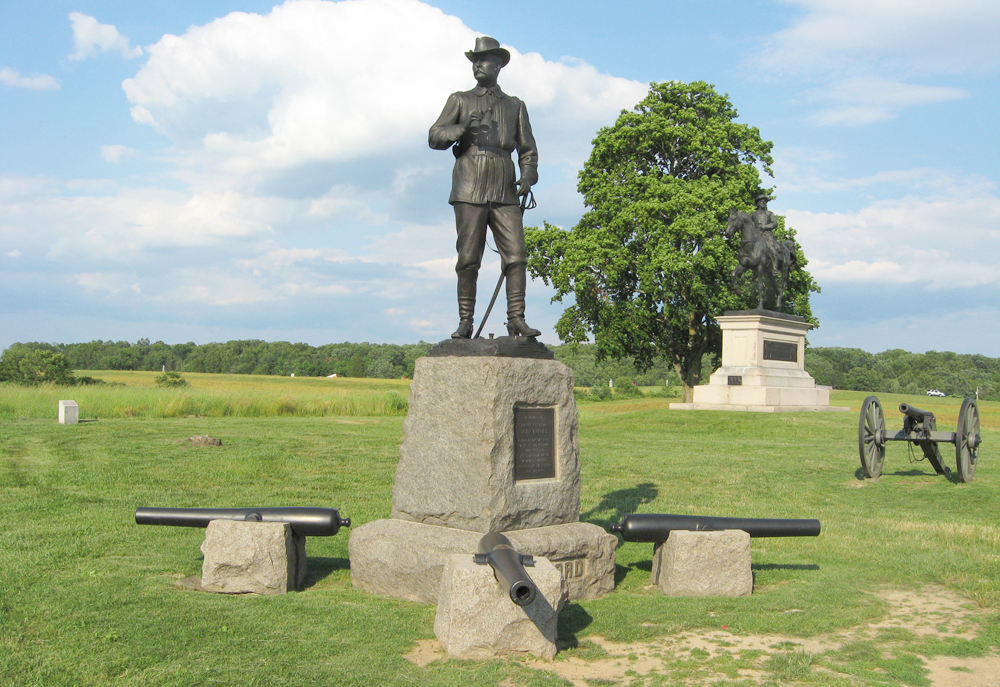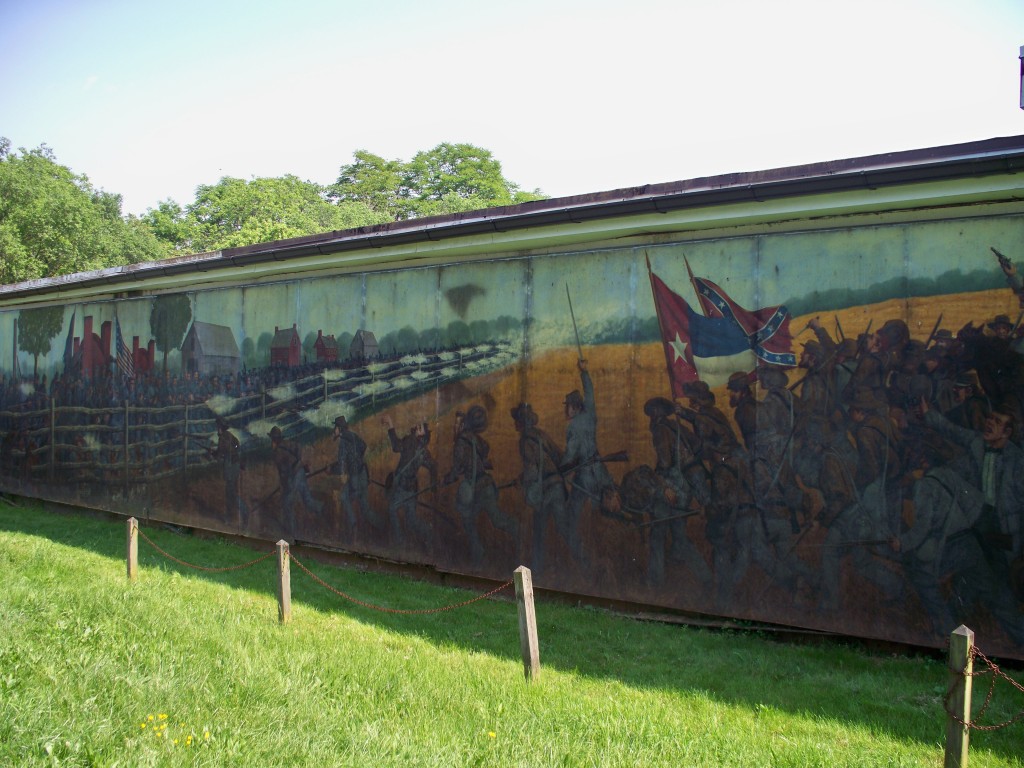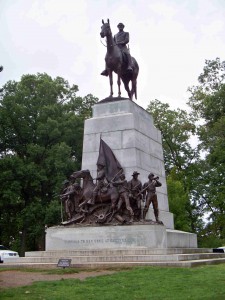Tag: Gettysburg Memorials

Battlefield Highlights: Where the Battle Began – Buford Holds The High Ground
May 30, 2023Have you ever wondered about the pivotal moments that shaped the outcome of the American Civil War? One such moment occurred on the first day of the Battle of Gettysburg.
General John Buford’s actions on that first day at Gettysburg were crucial in determining the final outcome of the battle. By holding the line against Confederate forces, he helped buy time for the Union army to reinforce its position, an action that ultimately determined the course of the entire conflict.
The Lonely Mural
August 15, 2012What if we told you there was a Gettysburg memorial worth a quarter of a million dollars–$250,000!–and that you’ve probably never seen it? Would you believe us? Well, it’s true! And unless you’re a diehard Gettysburg groupie, chances are that you haven’t even heard of it.
The Coster Avenue Mural in Gettysburg was designed by artist, historian, and Civil War descendant Mark H. Dunkelman, who painted it with the assistance of mural master Johan Bjurman. Dedicated on the 125th Anniversary of the Battle of Gettysburg, the mural depicts the clash between Union Colonel Charles R. Coster’s forces (27th Pennsylvania, 134th & 154th New York Regiments) and the Confederates led by Brigadier General Harry Hays & Colonel Isaac Avery.
Coster’s Brigade made their stand behind a fence-line in Kuhn’s Brickyard, taking what little shelter they could from the wooden fence posts, but mostly exposed to enemy fire. The Confederates, who far outnumbered the Union soldiers, descended upon the fence so quickly that Coster’s men only had time to fire six to nine shots each before the fight broke into clusters of hand-to-hand combat. Confederate forces overwhelmed the smaller contingent of Union soldiers, taking many of them prisoner and pursuing others nearly to Cemetery Hill. All told, it was a brief, brutal assault that took the lives of 563 of Coster’s men, while the Confederates lost 200 of their own.
National Park personnel report that Coster Avenue, the site of this breathtaking mural and monument, is the least visited portion of the battlefield. Overlooked, unknown, and often alone, it’s a sad truth that this memorial to American soldiers is not often remembered.
Will you be the exception? Will you remember the forgotten soldiers, who fought and died in Gettysburg?
The Virginia Monument
October 18, 2011The Civil War saw our country split in two—North and South, Union and Confederate—but regardless of who was right, both sides were fighting for their beliefs, their families, and their way of life. It’s impossible to look at it as good guys vs. bad guys because it isn’t that simple. Good men fought and died on both sides of the battlefield, and it is only right to honor them. That is why Gettysburg features statues of both Union heroes, like the Pennsylvania State Memorial, and statues of Confederate heroes, like The Virginia Monument.
The Virginia Monument was the first of the Confederate monuments to be built at Gettysburg, and it remains the largest. It was commissioned on March 9, 1908 and cost $50,000, which, in today’s money, is the equivalent of $885,000. That’s pretty expensive! It towers forty-two feet above Seminary Ridge, just East of Spangler Woods and accessible by West Confederate Ave.
The primary sculpture is a 14-foot bronze portrait of General Robert E. Lee, mounted upon his horse Traveller. Lee rides high on a 28-foot granite pedestal with seven Confederate soldiers beneath him. Their bronze eyes survey the field before them: site of the famous infantry assault of Pickett’s Charge. On the other side of the field is Cemetery Ridge, where the Union lines made their stand. There, a statue of General George Meade meets Lee’s gaze.
The seven Confederate soldiers, according to sculptor Frederick William Sievers, are representative of the men of all walks of life who left home and trade behind to serve in the military. First, there are two riflemen, one symbolic of a professional man, the other a mechanic. Beside them, a man who was an artist now aims a pistol. In the center, a boy on horseback raises the Confederate flag. To his right, a businessman swings a bayonet, a farmer raises a rifle, and a youth sounds a bugle call. These smaller portraits remind us that they were more than just soldiers.
The monument, minus the sculptures, was installed in 1913 and dedicated at the Gettysburg reunion—the 50th anniversary of the battle, which saw over 50,000 veterans gathered together from both sides of the war. The completed statue was unveiled in 1917 by Miss Virginia Carter, General Lee’s own niece, and presented by Henry C. Stuart, the governor of Virginia.
To visit this remarkable piece of history, plan your trip to Gettysburg Battlefield Tours today!
The Pennsylvania State Memorial
September 20, 2011Nothing seems to stand the test of time quite like a monument. Buildings, cities… even civilizations come and go, leaving little behind for us to glean their nature from. Monuments last. The Pyramids of Giza, the Maoi heads of Easter Island, the Parthenon: all still standing. What might future archaeologists determine about us from the Washington Monument? The Statue of Liberty? Or how about the Pennsylvania State Memorial?
 If you’re not in the know, the Pennsylvania State Memorial adorns the Gettysburg Battlefield, a tribute to the Pennsylvanian soldiers who fought there. Standing an impressive 110 feet tall, you can’t miss it; it’s the largest monument on the battlefield. The base is a pedestal, accessible by stairs, from which four grand supporting towers rise to support the dome and arches. The Northeast column houses a spiral staircase that leads to an observation deck with a breathtaking view of the battlefield: don’t miss it!
If you’re not in the know, the Pennsylvania State Memorial adorns the Gettysburg Battlefield, a tribute to the Pennsylvanian soldiers who fought there. Standing an impressive 110 feet tall, you can’t miss it; it’s the largest monument on the battlefield. The base is a pedestal, accessible by stairs, from which four grand supporting towers rise to support the dome and arches. The Northeast column houses a spiral staircase that leads to an observation deck with a breathtaking view of the battlefield: don’t miss it!
As you walk the perimeter of the monument, you will notice ninety bronze, name-covered tablets embedded in the granite surface. Each plaque represents a Pennsylvanian regiment, and each name belongs to one of the 34,530 Pennsylvanian fighting men who served his family and his country in the Battle of Gettysburg. Those who were killed in the line of duty are marked with stars beside their names, to help us remember the cost of war.
Also noteworthy are the larger-than-life statues that are incorporated in the monument. Eight portrait statues, two facing in each direction, depict the heroic leaders who took part in the battle. Seven are Pennsylvanians, including General George Meade, who commanded the Army of the Potomac, and Pennsylvania Governor Andrew Curtin, who delayed Lee’s troops in Virginia and put together a state militia. The eighth statue is of President Abraham Lincoln, whose Gettysburg Address is among the nation’s most famous speeches.
Crowning the Pennsylvania State Monument is an even larger statue (21 feet tall) made with the bronze of melted-down cannons and known as The Goddess of Victory and Peace. This was modeled by sculptor Samuel Murray, who also did some bas-relief scenes and detail work on the monument. The goddess sculpture is symbolic of our preference for peace and our willingness to do what’s necessary to protect it.
What else might future archaeologists find in and around the battlefield? Visit Gettysburg and find out! Or go on our website!

